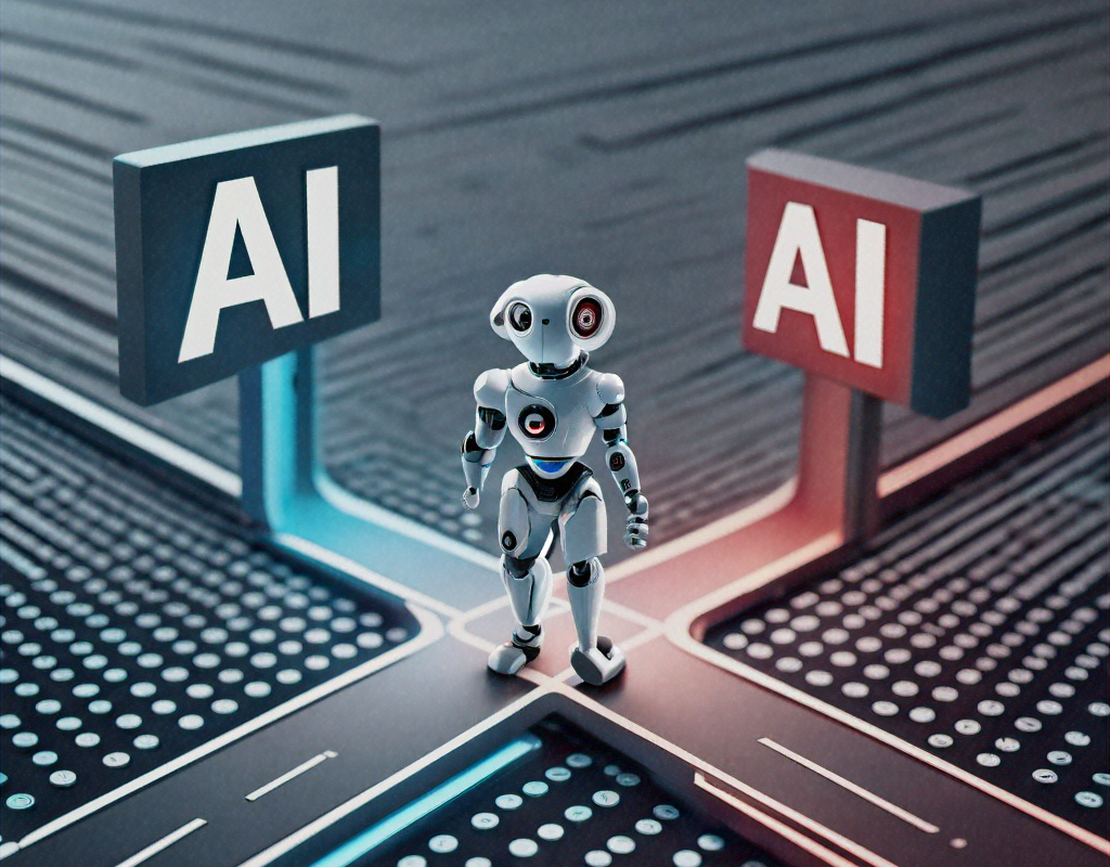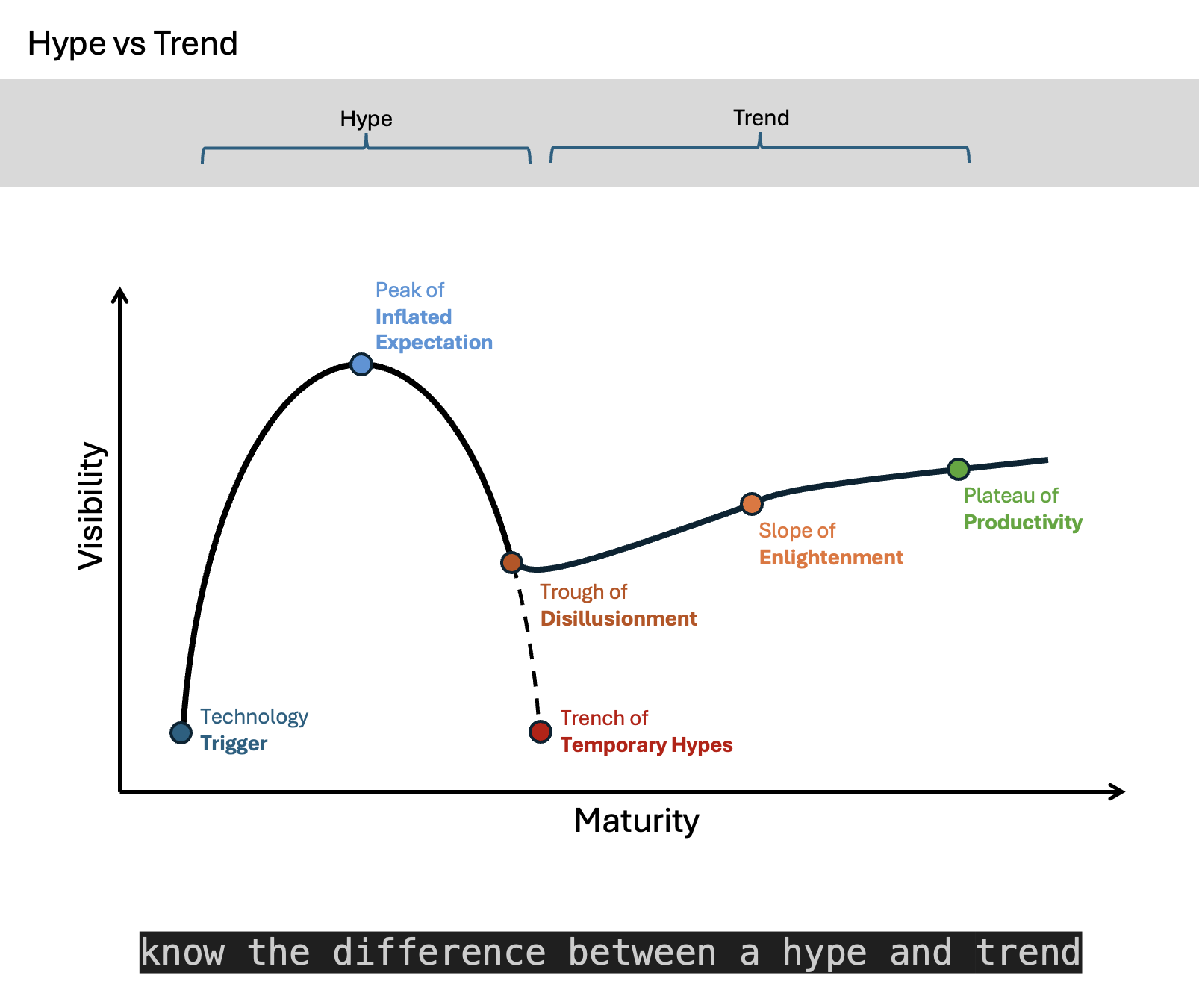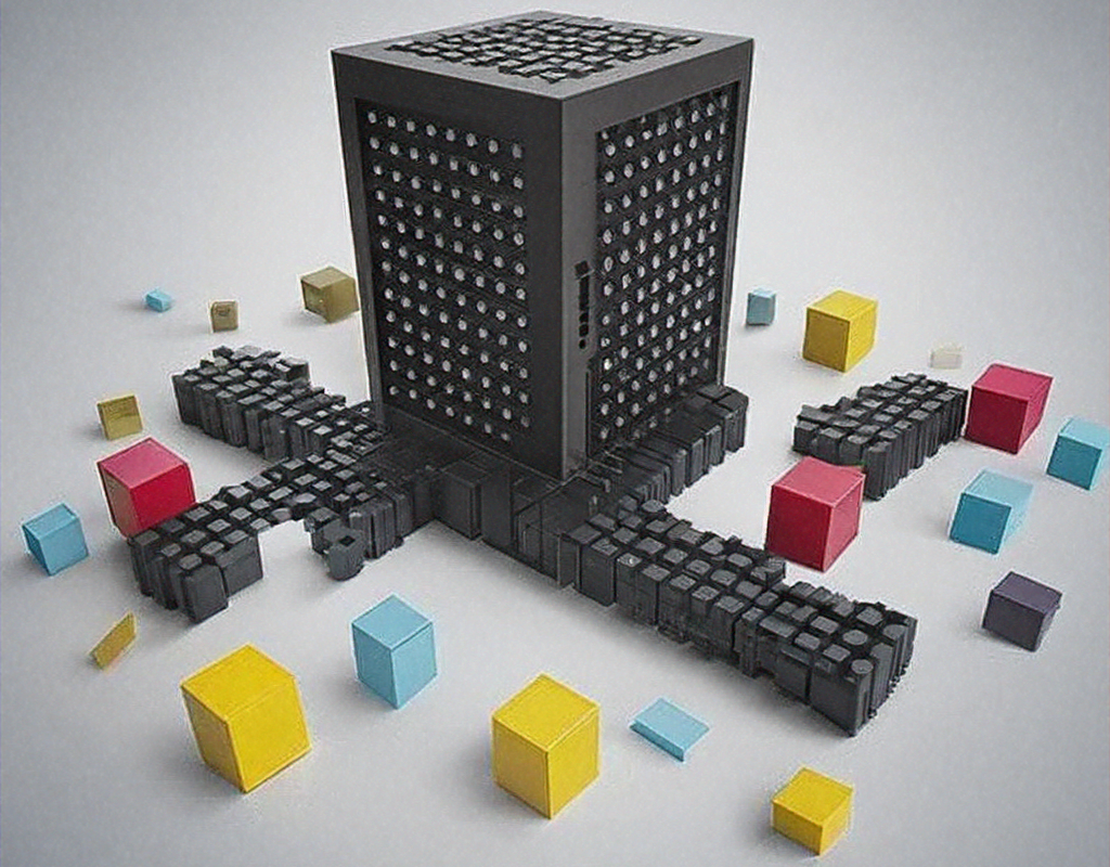
GenAI... Are we there yet?
- Aws solution architect
- October 11, 2024
- 10 min read
- Original: AWS Internal Wiki
Table of Contents
Separating Hype from Trend
We have talked a lot about the philosophy of being a Solution Architect, looking at the holistic perspectives of solution design, and mechanisms that help us to see the wider interconnectivity and emergent behaviors, as well as practical tools to help us to experiment and strengthen our abilities, ensuring our solutions evolve in tandem with the ever-changing landscape of technology and business needs.
However, we haven’t really discussed what a pivotal position that Solution Architects occupy. We are strategic visionaries, guiding our customers through the complexities of digital transformation. By blending cutting-edge technologies, industry best practices, and domain-specific expertise, we connect business and technology realms and translate complex requirements into scalable, future-proof solutions that drive innovation and competitive advantage.
As the tech landscape continues to evolve at an unprecedented pace, Solution Architects must be adept at staying ahead of the curve, anticipating emerging trends, and leveraging disruptive technologies to craft solutions that not only meet current demands but also pave the way for future growth and adaptability. By fostering cross-functional collaboration and fostering a culture of continuous learning, we ensure that our partners and customers remain agile and resilient in the face of rapidly changing market dynamics.
So, what better way to look at where we fit into this continuous evolving tech landscape then to look at current tech events?
By now, unless you have been working in a deep underground lab disconnected from the world (where do I sign up for that role?), you will have been surrounded by the Generative Artificial Intelligence (GenAI) fervor. Every conversation in the last two years seemingly involves GenAI. And what’s not to be excited about a rapidly advancing field that has captured the imagination of technologists, businesses, and the general public alike? From language models like ChatGPT and Claude to image generators like Stability AI, DALL-E, and Midjourney, or tools with GenAI at the core like Amazon Q, Scribe, and CoPilot. These powerful AI systems are demonstrating remarkable capabilities in generating human-like text, images, code, and more.
But amidst the fervor surrounding GenAI, it’s crucial as a Solutions Architect to understand our role in all the excitement and importantly distinguish between hype and trend – a distinction that will shape the strategic decisions of our solutions and the advice we provide to partners and customers alike.
The Hype vs Trend Dichotomy
To make the right strategic decisions, it is key to know the difference between a hype and a trend. Both provide opportunities, but in very different ways. Can you tell the difference?
Hypes are characterized by their novelty, excitement, and often, overestimation. They generate a whirlwind of attention and buzz, with “experts” popping up everywhere, promising quick success and first-mover advantages. However, hypes are typically short-lived, unpredictable, and carry significant risks. They ask for fast reactions, but their impact is often fleeting.
In contrast, trends are more subdued and seemingly repetitive, often underestimated and overlooked. Yet, they create lasting impact and real change, driven by a smaller group of competent experts. Trends are relatively predictable and reliable, asking for a solid, fundamental response. While they may not offer the allure of overnight success, trends pave the way for consistent, long-term achievements.
The Gartner Hype Cycle, a widely recognized tool, provides a framework for understanding the lifecycle of emerging technologies, including GenAI. It outlines five phases:
Technology Trigger: At this stage, a novel technology makes its debut appearance before the public eye. It emerges from diverse spheres such as burgeoning markets, research laboratories, think tanks, and academic institutions. Invariably, this unveiling is accompanied by a whirlwind of excitement and hype surrounding the product’s prospective applications. While tangible, fully-functional products may not yet exist, prototypes and concept demonstrations often take centre stage, fuelling media attention and stoking anticipation regarding the technology’s potential impact.
Peak of Inflated Expectations: As the innovative technology gains traction, media outlets and industry experts amplify their coverage, fuelling a surge of excitement and often inflating expectations about its capabilities beyond realistic bounds.
Trough of Disillusionment: As the novelty wears off and practical hurdles come into focus, the initial fervour surrounding a new technology starts to wane, prompting scepticism about its feasibility and practical applications.
Slope of Enlightenment: As the product matures, stakeholders gain a more grounded understanding of its strengths, weaknesses, and practical applications. This knowledge enables them to harness its potential more effectively across various contexts and scenarios.
Plateau of Productivity: During the maturity stage, the product achieves widespread familiarity and acceptance in the market. Consumers have gained a comprehensive understanding of its functionalities, enabling them to harness its capabilities effectively. Consequently, this phase is marked by heightened productivity, as users have mastered the art of optimizing the product’s features to their advantage.
And not officially part of the Gartner Hype Cycle, but for technologies that don’t make it past the slope of enlightenment into the plateau of productivity, is the ‘Trench of temporary hypes’ - This is where tech goes to slowly phase out, due to an understanding of the techs capabilities and applications not providing the desired outcomes or productivity required to take advantage of the technology.

GenAI and the Hype Cycle
As of the writing of this article, it seems like GenAI is riding the Peak of Inflated Expectations, with unrealistic expectations about its potential and widespread media hype. However, as limitations and challenges become more apparent, the technology may soon enter the Trough of Disillusionment.
Several factors will influence where GenAI ultimately lands on the Hype Cycle:
Sustainability and Cost: In its current form, GenAI is computationally intensive and energy-hungry, raising concerns about its sustainability and cost. Researchers and developers must find ways to make these models more efficient and affordable, potentially through techniques like model compression or “Agentic” (agent-of-agents) architectures.
Quality and Reliability: Like any AI system, GenAI models are susceptible to the “garbage in, garbage out” principle. If trained on biased or low-quality data, their outputs will reflect those biases and limitations. Ensuring high-quality, unbiased training data and robust evaluation methods is crucial for reliable and trustworthy GenAI systems.
Safety and Ethics: As GenAI systems become more powerful and ubiquitous, concerns around data privacy, ethical use, and potential misuse will need to be addressed. Questions arise about the responsible use of personal data, the impact on jobs and industries, and the need for governance and regulation.
Even if GenAI ends up in the ’trench of temporary hypes,’ there is still a lot to learn. At Amazon, we’ve seen the ups and downs that come with innovating and taking big swings in the market. Remember the Fire Phone? While it was a humbling experience, there were also some incredibly valuable learnings.
The Role of Solutions Architects
As Solutions Architects, our role in navigating the GenAI landscape is multifaceted. On one hand, we must stay abreast of the technical advancements and understand the capabilities and limitations of these systems. This knowledge will enable us to guide our customers in leveraging GenAI effectively and responsibly. On the other hand, we must look beyond the hype and instead of fixating on the intricacies of language models or image generators, our attention should be directed towards applications like improved search and retrieval, content generation, or automating repetitive tasks.
Ultimately, our job is to focus on solving real-world problems - GenAI is just the latest tool in the toolkit. By taking a problem-centric approach, we can differentiate ourselves as “10x builders” – professionals who create scalable, impactful solutions that outlive the hype cycles and contribute to sustainable trends.
Furthermore, as field technologists, we have a unique opportunity to influence the GenAI hype cycle itself. Companies like Amazon have been at the forefront of innovation, triggering hype cycles with services like AWS Lambda and the serverless revolution, and even the advent of cloud computing itself. Similarly, we can shape the trajectory of GenAI by developing innovative solutions, pushing the boundaries of what’s possible, and demonstrating real-world value.
Conclusion
The rise of Generative AI presents both exciting opportunities and significant challenges. But remember: today it is GenAI, but there’s another hype cycle just around the corner. As Solutions Architects, it is our responsibility to navigate the technology landscape with a discerning eye, separating hype from trend, and focusing our efforts on creating sustainable, impactful solutions that solve real-world problems.
By embracing a problem-centric mindset, staying abreast of technical advancements, and addressing concerns around sustainability, reliability, and ethics, we can harness the power of any technology while mitigating its risks. In doing so, we can contribute to the broader trend of democratizing technology for the greater good, fostering innovation, and driving meaningful progress across industries and societies.


